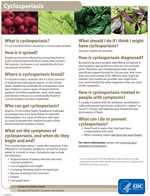Prevention & Control
On the basis of the currently available information, avoiding food or water that may have been contaminated with feces is the best way to prevent cyclosporiasis. Treatment with chlorine or iodine is unlikely to kill Cyclospora oocysts. No vaccine for cyclosporiasis is available.
The U.S. Food and Drug Administration's (FDA) Center for Food Safety and Applied Nutrition (CFSAN) publishes detailed food safety recommendations for growers and suppliers. In its Guide to Minimize Microbial Food Safety Hazards for Fresh Fruits and Vegetables, CFSAN describes good agricultural practices (GAPs) and good manufacturing practices (GMPs) for fresh fruits and vegetables. The guidelines address the growing, harvesting, sorting, packaging, and storage processes; following the guidelines can help reduce the overall risk for microbial contamination during these processes. The precise ways that food and water become contaminated with Cyclospora oocysts are not fully understood.
CDC monitors the occurrence of cyclosporiasis in the United States and helps state health departments identify and investigate cyclosporiasis outbreaks to prevent additional cases of illness.
More on: Surveillance and Outbreak Response
- Page last reviewed: June 13, 2014
- Page last updated: June 13, 2014
- Content source:



 ShareCompartir
ShareCompartir